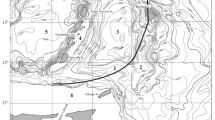Abstract
Tectonic typification of the abyssal basins of the Atlantic, Indian, and Pacific oceans is proposed. Six types of basins are recognized: perispreading, pericontinental, central thalassogenic, intermontane abyssal, interfault, and thalassosyneclise. The tectonic diversity of the basins and their systems reflects significant regional tectono-geodynamic features of the oceanic lithosphere. Basins of the first type are inherent to the Atlantic Ocean; of the second and third types, to the Indian Ocean; and of the fourth to sixth types, to the Pacific. In the Atlantic Ocean, the basins are spatially and paragenetically conjugated with the mid-oceanic ridge. Beyond the Atlantic, a similar situation is characteristic of the southern Indian Ocean only. Hence, differentiated energetic models of deep geospheres are required. The relations of potentially economic fields of ferromanganese nodules to tectonic types of abyssal basins are discussed. The largest fields with respect to both dimensions and reserves are confined to interfault and intermontane abyssal basins. The fields localized in central thalassogenic basins are second in importance. The perispreading and pericontinental basins are the least promising in this respect. Along with other criteria, tectonic analysis should be taken into consideration in the future development of these valuable mineral resources.
Similar content being viewed by others
References
S. I. Andreev, L. I. Anikeeva, A. N. Vishnevsky, et al., “Mineral Resources of the World Ocean, Their Potential, and Prospects for Development,” in Geology and Mineral Resources of the World Ocean (VNIIOkeangeologiya, St. Petersburg, 1995), pp. 141–157 [in Russian].
L. I. Anikeeva, S. I. Andreev, P. A. Aleksandrov, and V. E. Kazakova, “Cobalt-Bearing Crusts in the World Ocean: Geochemistry, Genesis, and Abundance,” Razved. Okhr. Nedr, No. 1, 47–54 (2005).
E. S. Bazilevskaya, Study of Iron-Manganese Ores in Ocean (Nauka, Moscow, 2007) [in Russian].
I. F. Glumov, A. I. Glumov, Yu. B. Kazmin, and V. M. Yubko, “Mineral Resources of the International Sector of the World Ocean Floor,” Geol. Polezn. Iskop. Mirovogo Okeana, No. 1, 11–28 (2005).
Information Resources and Results of Geological and-Geophysical Investigations on the Mascarene-Australia Geotraverse in the Indian Ocean, Ed. by V. S. Shcherbakov and V. N. Zhivago (GUGP GlavNIVTs, Moscow, 2001) [in Russian].
Yu. D. Markov, A. V. Mozherovsky, and V. S. Pushkar, “Specific Features of Sedimentation and Stratigraphic Correlation of Unconsolidated Sediments of the Clarion Transform Fault Zone (Northeastern Pacific Ocean),” Tikhookean. Geol. 24(4), 24–43 (2005).
Metallogenic Map of the World Ocean. Explanatory Notes, Ed. by S. I. Andreev (VNIIOkeangeologiya, St. Petersburg, 1998) [in Russian].
V. N. Moskalenko and L. I. Kogan, “Specific Features of Sedimentary Cover in the East Part of the Azores-Gibraltar Zone (Horseshoe Basin),” Geotektonika 29(4), 63–72 (1994).
Yu. P. Neprochnov, “The 31st Leg of R/V “Dmitrii Mendeleev,” Okeanologiya 25(2), 361–365 (1985).
Yu. P. Neprochnov, G. M. Valyashko, L. P. Volokitina, et al., “Detailed Geologicand Geophysical Surveying in the Mendocino Fault Zone,” Okeanologiya 33(2), 253–262 (1993).
V. V. Popov and Yu. G. Safonov, Mineral Resources of the Fuel-and-Energy and Metallurgical Complexes of Russia (IGEM RAS, Moscow, 2006) [in Russian].
Yu. M. Pushcharovsky, Tectonics of the Atlantic with Elements of Nonlinear Geodynamics (Nauka, Moscow, 1994) [in Russian].
Yu. M. Pushcharovsky, “Deep Basins of the Atlantic Ocean: Structural Features, Time and Mechanism of Their Formation,” Ross. Zh. Nauk Zemle 6(1), 1–15 (2004).
Yu. M. Pushcharovsky, “Tectonic Types of the Pacific Abyssal Basins,” Geotektonika 40(5), 25–38 (2006) [Geotectonics 40 (5), 345–356 (2006)].
Yu. M. Pushcharovsky, “Comparative Tectonics of Abyssal Basins of the Atlantic, Pacific, and Indian Oceans,” Dokl. Akad. Nauk 409(1), 90–93 (2006) [Dokl. Earth Sci. 409 (5), 713–716 (2006)].
Yu. M. Pushcharovsky, “Tectonic Types of Abyssal Basins in the Indian Ocean,” Geotektonika 41(5), 23–27 (2007) [Geotectonics 41 (5), 355–367 (2007)].
Yu. M. Pushcharovsky and S. G. Skolotnev, “Regional Geological Studies as a Basis for Tectonic Demarcation of the Oceanic Floor,” Geotektonika 39(1), 1–23 (2005) [Geotectonics 39 (1), 14–34 (2005)].
S. G. Skolotnev, S. Yu. Kolodyazhny, N. V. Tsukanov, et al., “Neotectonic Deformations and Structures in Junction Zone of the Cape Verde Uplift and Cape Verde Abyssal Basin (Central Atlantic),” Dokl. Akad. Nauk. (in press).
S. Scott, “Prospects of Mining of Manganese Nodules, Crusts and Base-Metal Sulfides in Oceans,” in Metallogeny of Ancient and Modern Oceans (Inst. Mineralogy, Miass, 2000), pp. 33–40 [in Russian].
G. B. Udintsev, Topography and Structure of Oceanic Floor (Nedra, Moscow, 1987) [in Russian].
I. V. Khvorova, Two Types of Pacific Thalassogenes and Their Sedimentary Rocks (Nauka, Moscow, 1993) [in Russian].
P. D. Clift and J. M. Lorenzo, “Flexural Unloading and Uplift along the Cote D’Ivoire-Ghana Transform Margin Equatorial Atlantic,” J. Geophys. Res. 104(B11), 25257–25274 (1999).
GEBCO, General Bathymetric Chart of the Ocean, 5th Edit. (Ottawa, 1984).
D. T. Sandwell and W. H. F. Smith, Marine Gravity Anomaly from Satellite Altimetry. Map (La Jolla, 1997).
Ch. Steiner, A. Hobson, and Ph. Favre, at al., “Mesozoic Sequence of Fuerteventura (Canary Islands): Witness of Early Jurassic Sea-Floor Spreading in the Central Atlantic,” Geol. Soc. Am. Bull. 110(10), 1314–1318 (1998).
Author information
Authors and Affiliations
Corresponding author
Additional information
Original Russian Text © Yu.M. Pushcharovsky, 2008, published in Geotektonika, 2008, No. 4, pp. 3–17.
Rights and permissions
About this article
Cite this article
Pushcharovsky, Y.M. Tectonic types of oceanic abyssal basins and related potentially economic fields of ferromanganese nodules. Geotecton. 42, 245–257 (2008). https://doi.org/10.1134/S0016852108040018
Received:
Published:
Issue Date:
DOI: https://doi.org/10.1134/S0016852108040018




